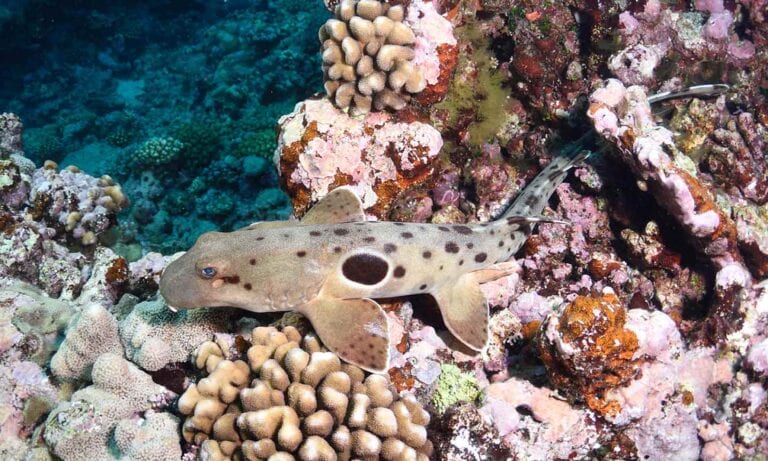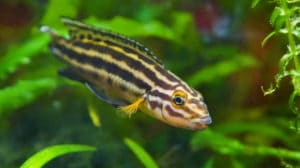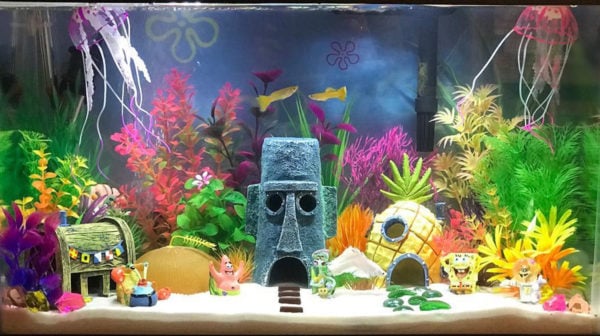Microalgae. How we loathe it! It can cause reef aquarists great despair as it smothers their corals or makes a once-gorgeous reef tank look like an overgrown meadow. We try to avoid this by keeping phosphate and nitrate levels down (food for algae), adding herbivorous invertebrates (snails and hermit crabs) to reduce algae and also seeking the assistance of algae-eating fish (tangs and rabbitfish, among others). Members of these two fish families can help control algal growth, but they are large and need a lot of swimming room.
There is, however, another group of piscine herbivores that can be enlisted in the war on algae. These are the blennies (family Blenniidae). We will examine several of the most common blenny groups encountered by aquarists.
Highfin Blennies
The highfin blennies (Astrosalarias) have big eyes and look like ghostly creatures when they swim around. There are two species: the highfin or brown coral blenny (A. fuscus) and the hosokawa blenny (A. hosokawai). The latter is rarely seen in the aquarium trade.
Lawnmower blenny
While the lawnmower blenny (Salarias fasciatus) may be employed to help control pestilent algae, other members of the family will also fit this role. Photo by Scott W. Michael
Atrosalarias fuscus is a solitary species that usually lives among live and dead branching corals on coastal reefs, reef flats and protected outer reef faces. It tends to be a shallow water species and is very tolerant of low oxygen levels. This is an adaptation to living deep within coral colonies, where low oxygen conditions may occur (especially at night), or of inhabiting tidepools, which are often oxygen-deprived, due to the smaller water volume and heating by the sun. This blenny feeds mainly on filamentous microalgae, foraminiferans, detritus and sand. It also consumes sponges, fish eggs, minute crustaceans, small snails, insects (yes, insects) and small polychaete worms. It is thought that many of these organisms are ingested incidentally as the fish feeds on algae.
Aquarium Care
In captivity, the highfin blenny is sometimes used to help curb filamentous microalgae growth. Although it feeds primarily on algae, on rare occasions, an individual may nip at coral polyps or clam mantles; they are more likely to partake in this undesirable behavior if algae is in short supply. This species (and all the algae-eating blennies) do best in a tank that has a good crop of microalgae. Because of this feeding requirement, it’s also important that the tank be large enough to provide enough fodder. While you might think that a smaller A. fuscus would be better suited for a smaller tank, juveniles have greater metabolic needs than adults. A tank of 55 gallons or larger is recommended for any highfin blenny. Of course, the size of the tank is also a function of how many food competitors are housed with the blenny. If you think food supplies may be limited, avoid adding microalgae eaters (damsels, other blennies and surgeonfish). Although some individuals will eat added aquarium foods (such as frozen foods that contain the blue-green algae Spirulina), do not count on it.
It’s best to keep only one A. fuscus per tank, unless you can acquire a male-female pair or your tank is very large (135 gallons or more). It has been suggested that males are typically larger than females, but more data is needed to confirm this theory. While A. fuscus is not particularly aggressive, it has been known to pester smaller members of the family. For example, resident A. fuscus will occasionally chase and nip at newly introduced blennies in the genera Blenniella and Ecsenius. These clashes are more likely in a smaller fish aquarium.
Rockskippers
The rockskippers (Blenniella, Instiblennius) are unique members of a family that usually occurs in habitats impacted by strong waves in the intertidal zone. They regularly flip (or “skip”) from one tidepool to the next, often leaving the water for short periods of time when making these migrations. These blennies even hang onto rocks out of the water as the waves recede.
Rockskippers rasp the substrate, ingesting filamentous microalgae and minute invertebrates that associate with this plant material (including foraminiferans, ostracods, copepods and tiny gastropods). However, it may not be the algae itself or the various invertebrates that are the most important constituents of the rockskipper’s diet. Instead, it’s thought the detritus that accumulates in the microalgae is the key dietary component.
Some of the rockskippers live in groups. Males of at least some species do maintain a territory during the breeding season, within which is a nesting site (usually located in a tidepool crevice). Studies have shown that (as opposed to smaller males) larger males spawn with more females. The males guard the eggs until they hatch, fending off the attacks of various egg-predators, including wrasses, crabs and sea urchins. The adults themselves are eaten by various piscivorous fish (e.g., morays, groupers) and sea snakes.
Aquarium care. It is best to place a rockskipper in a tank that has been set up for a while (say, six months or more) and thus has some microalgal growth present for it to feed on. I’ve had to move individuals I’ve kept in newly set-up tanks because they would have starved, even though they were ingesting algae-based foods I added to the tank. Thus, I think the key may indeed be detritus. If there is not enough of this material accumulating, these fish will have a difficult time getting enough to eat. If your tank does not contain this important food source, frequent feeding (at least four or five times a day) is the only other way to keep them fat and “happy.” Unfortunately, the very algae we don’t want in our reef tanks — filamentous forms of microalgae — tend to trap the most detritus.
Another major cause of rockskipper death is “carpet surfing.” That is, they jump out of open aquariums or even holes in the tank top, drying to death on the carpet. In some cases, they may end up quite a distance from their aquarium because they are efficient at skipping along the floor.
Although these blennies are not known coral-eaters, on rare occasions they have been known to nip at corals or clam mantles. However, they usually do not cause irreparable damage to these sessile invertebrates. They are more likely to nip at corals when starving.
Rockskippers may quarrel if more than one is placed in a smaller aquarium, but they can be kept together in a larger tank (135 gallons or more). They may also attack other elongated, bottom-dwelling fish, such as gobies and food competitors (other detritus feeders, such as bristletooth surgeonfish, Ctenochaetus spp.). To ensure that your rockskipper gets enough to eat, it’s a good idea to avoid adding food competitors to its home.
Combtooth Blennies
This genus of handsome blennies, Cirripectes, contains 22 described species. Their aesthetic qualities (many exhibit attractive colors) and algae-eating habits make them desirable to many aquarists. However, there are some drawbacks to keeping these fish.
The jaws and upper lip of Cirripectes are adorned with hundreds of small, flexible teeth used to rasp filamentous algae and detritus off of hard substrates. These blennies incidentally ingest foraminiferans, ostracods and tiny gastropods that associate with this plant material. They may feed on corals on rare occasions. For example, in a study that examined the stomach contents of two redspeckled blenny (C. variolosus) specimens, one contained a few small stony coral fragments (Hobson, E.S. 1974. “Feeding relationships of the teleosteon fishes on coral reefs in Kona.” Fishery Bull. 72:915-1031). These may have also been ingested while the blenny was feeding on plant material.
The members of this genus are territorial, with the focal point of their protected space being one or more holes in which to shelter. On the reef, they live within the territories of larger herbivores, such as damsels and surgeonfish.
Aquarium Care
These hefty blennies are not as common in the aquarium trade as some of their smaller cousins. Like many in the family, they can be housed in a reef tank but are a potential threat to stony corals. Although it is not common, members of the genus have been known to nip large-polyped stony corals. Also, as mentioned before, pieces of scleractinian coral had been found in one blenny‘s stomach contents. They might also nip at clam mantles. Coral and clam nipping is more likely to occur if a Cirripectes doesn’t have sufficient food. They might actually benefit SPS corals by helping to circulate fresh, oxygen-enriched water within the coral colony as the fish moves among the branches. Although other fish do this as well, not many spend most of their time with stony coral colonies like the Cirripectes do.
It is prudent to keep only one member of the same Cirripectes species per tank, unless you can acquire a heterosexual pair. Cirripectes are also likely to fight with species members if the tank is smaller, with the more similar-looking species being more likely to do battle. They can be kept with other blennies in a larger aquarium (135 gallons or greater). They may chase smaller herbivores out of their territories, and will occasionally bite the flanks or fins of food competitors. This is, of course, more likely if space is at a minimum. Their numerous teeth leave tell-tale abrasions on the on the body and fins of their victims. They are capable jumpers — so remember that a cover is a necessary addition to the Cirripectes aquarium.
Before you add more than one blenny to your aquarium (or a bag full of snails and other microalgae-eating invertebrates), consider the tank’s carrying capacity. In many cases, a smaller to medium-sized aquarium will not provide enough food for a large Cirripectes blenny. This can be problematic if you cannot get the blenny to switch from its natural botanical fodder to added foods. You can attempt to feed these blennies an herbivore diet (e.g., frozen preparations and flake foods that include Spirulina algae), however some individuals are reluctant to eat anything but filamentous microalgae and detritus. For this reason, you should probably not risk adding more than one of these blennies to a tank of less than 100 gallons, taking into account that this is a rough estimate — the lushness of the algal crop in a tank will also determine how many blennies can survive in it.
Big-lipped blennies
Big-lipped blennies (Ophioblennius) are familiar to anyone who has snorkeled in the Caribbean or the Gulf of California. Although they are not common in the aquarium trade, they do show up on occasion. Special consideration should be given before purchasing one of these potentially belligerent blennies.
These blennies use their expandable jaws to rasp algae and micro-invertebrates off of hard substrates. Food habits of the redlip blenny (O. atlanticus) indicate that it feeds almost entirely on algae and detritus: mostly blue-green algae (cyanobacteria) and diatoms, but also green filamentous algae on occasion. Foraging activity occurs during the day, with Ophioblennius taking shelter in reef holes and crevices at night.
Aquarium Care
The big-lipped blennies are durable aquarium inhabitants that can be useful in helping to control microalgae. But before you run out and purchase an Ophioblennius, be aware that these larger blennies should be housed in a moderate to large aquarium. A tank of 55 gallons is recommended for an adult specimen, but even in a tank this size, an adult big-lipped blenny can become a troublesome neighbor.
Because of their disposition, Ophioblennius are often relegated to a species tank. These blennies are highly territorial. In the wild, they will exclude members of their own kind, as well as other species that feed on algae, or try to enter their preferred hiding places. In an aquarium, they are less selective about who they attack. They will chase or dash out and nip almost any other fish that swims past, then quickly retreat back to their refuge before the victim can turn and retaliate.
Some fish that have been known to be attacked by Ophioblennius are dwarf seabass, angelfish, butterflyfish, other blennies, dragonets, gobies, surgeonfish and rabbitfish. In smaller tanks, they may even kill smaller fish with their persistent attacks. These blennies have elongate canine teeth that they use during territorial disputes, so they are capable of doing some serious damage to rivals and food competitors.
It should be fairly obvious that only one Ophioblennius should be housed per tank. It’s possible to keep a heterosexual pair in a large tank (180 gallons or more), but they should be added together. Males can be particularly quarrelsome and may even batter females if space is limited.
Although Ophioblennius are usually not a great threat to invertebrates, a rare individual may attack crabs. For example, they have been observed tearing hermit crabs out of their shells and eating them. Like other blennies, Ophioblennius may also nip at large-polyped stony corals and clam mantles. However, this behavior is rare in well-fed individuals.
If you have a larger aquarium with a good crop of microalgae, it may not be necessary to feed these fish frequently. If natural foods are in short supply, however, you will need to feed them food that includes vegetable matter (e.g., flake foods, frozen preparations) several times a day. These blennies regularly ingest most aquarium foods. Like their kin, they have been known to jump out of open tanks or into overflow boxes.
Although algae-eating blennies can certainly serve a valuable purpose in reef aquariums, they can also eat themselves out of their aquarium home. While some individuals will readily take introduced aquarium fare, some are reluctant to do so. Therefore, before you purchase one of these helpful piscine personalities, make sure you have a suitable aquarium system to keep them healthy.
Posted by: Chewy Editorial
Featured Image: Via Scott W. Michael
Share:









